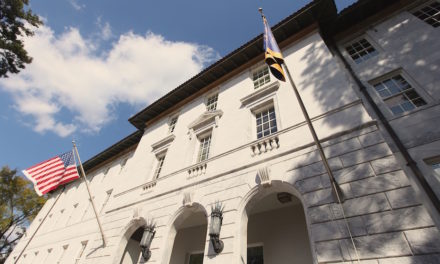
As part of the September 2012 announcement of department changes and the resulting formation of faculty task forces to examine new areas for growth, an Emory College faculty committee released a report titled “The Digital Studies and New Media (DS & NM) Across the Arts and Sciences” on Wednesday. In the report, the committee states that the College’s plan for journalism courses next year does not align with their recommendations.
The report states that the committee released the recommendations several months late and, therefore, could not provide “timely advice to the [College Dean Robin Forman].” At the same time, the report goes on to state that the committee chair, Sociology Professor Tim Dowd, informed Forman last summer that the committee would be making these recommendations.
Dowd said he had hoped that the report would be released in December but was delayed because of his own “personal issues.”
In that “vacuum” of time, faculty were “forced to make random and disconnected decisions about future Journalism courses, the effect of which has been to reduce Journalism’s presence much more severely than the committee had agreed to recommend … and to atomize the courses in ways the committee felt would be detrimental to students interested in Journalism,” the report stated.
“I don’t think the report coming out a couple months sooner would have had an immediate impact on the path that we’re following,” Forman said in an interview with the Wheel.
The Journalism Program and the DS & NM Report
Along with Dowd, the committee included Associate Professor of Mathematics and Computer Science Eugene Agichtein, Film and Media Studies Professor Matthew Bernstein, former Music Professor and Assistant Vice Provost of Academic Affairs Steve Everett, Religion Assistant Professor James Hoesterey, James M. Cox Jr. Journalism Professor and Journalism Program Director Hank Klibanoff, Faculty Services team member, Theater Professor and Director of the Center for Creativity and the Arts Leslie Taylor and History Professor and Co-Director of the Emory Center for Digital Scholarship Allen Tullos.
The report mentions Journalism courses that they believe are “essential,” “vital” and should be “bound together,” which are “News Writing and Reporting,” “News Literacy in a Digital Age,” “Digital Media, Journalism History and Ethics,” “News Video,” “Investigative Reporting” and “Internship in Journalism.”
Dowd said this recommendation does not involve keeping a journalism program but instead involves keeping select courses the program offered.
“It is the committee’s recommendation that many (if not most) of the courses currently taught in the Journalism Program remain as part of an academic whole that can preserve the high quality of instruction that grows from their cohesiveness,” the report states. “Such courses clearly address the digital tools and new media literacy we emphasize in our other recommendations above.”
Next fall, Klibanoff will join the Creative Writing Program in the English Department teaching the “Journalism History & Ethics” class in the Film and Media Studies Department and the “Civil Rights Cold Cases” course cross-listed in African American Studies, History and American Studies.
Journalism Professor Sheila Tefft will join the Institute for Liberal Arts, teaching “Health and Science Writing” and the freshman seminar “Discover International Atlanta” in the fall. Two journalism faculty will be leaving in the fall.
These fall plans for journalism, the report said, “unfortunately, provide none of the cohesion in Journalism that the committee had thought was so essential,” represent a “massive reduction” and do not include several of the courses that the committee wanted to keep.
In an interview with the Wheel, Forman said he would not comment on specifics because he has not had a chance to discuss the report with the committee yet. Early next week, Forman and Dowd will meet to discuss the report.
“That said, I think the idea of integrating Journalism courses into both Creative Writing and Media Studies is a rather exciting future,” Forman said.
A Proposal for a Journalism Concentration in Film & Media Studies
While the report mentions which journalism courses impressed them, it does not recommend where those courses should end up.
The report does mention that there were discussions about moving journalism courses into the Film & Media Studies Department.
Senior Associate Dean of Faculty Michael A. Elliot asked Bernstein to consider whether it would make sense to have some journalism courses in the department of Film & Media Studies, according to Elliot and Bernstein. Bernstein said that the he and the faculty were enthusiastic about the proposal.
In October, Bernstein sent a memo to Forman to include 11 journalism courses as a Journalism concentration in the Film & Media Studies department at the same time that he was submitting a proposal for Media Studies major, which is currently only a minor.
According to Bernstein, his proposal for a Journalism concentration was unsuccessful as Forman said that the College could not support all of those journalism courses within the Media Studies major. The Film & Media Studies department is still waiting on a conclusion about a Media Studies major. Bernstein said he needed the Dean’s support to present the proposal for the major to the curriculum committee, and the Dean said that this is the general procedure.
“What I had proposed was too extensive. I basically said, ‘All these courses are great,'” Bernstein said. “We just couldn’t do it. The College couldn’t do it.”
Klibanoff said it would not have been possible for the two remaining journalism faculty members to teach the proposed courses and, therefore, the College would have had to hire more adjunct professors.
Forman wrote in an email to the Wheel that he did not agree with Bernstein’s assessment that all 11 courses are essential for a Media Studies major.
“We had many conversations on the right way to support journalism courses in an ongoing fashion,” Forman said in the interview with the Wheel. “In these conversations, there are many viable ideas and … you make your best judgment.”
After Forman told Bernstein that his journalism plan was not viable, Bernstein proposed the Media Studies major last fall to the curriculum committee and did not include the journalism concentration. The proposal did include a statement stating that it was not feasible at that time to include journalism and that the department hopes to include journalism in the future.
“Indeed, journalism courses remain an important part of the media studies minor,” Bernstein wrote in an email to the Wheel.
Forman wrote in an email to the Wheel that he agrees with the committee about the value of journalism.
“That said, we are regularly put in the position of allocating scarce resources among many opportunities, all of which have great value,” Forman wrote. “And in the case of every program we offer, including journalism, there are those who are quite passionate and would like their program to receive more support.”
Klibanoff said Forman might not have been expecting this revival around journalism.
“No surprise the dean didn’t feel that strongly that the magnitude of journalism courses should not continue,” Klibanoff said. “And I guess the committee at that point could have backed down … It’s worth knowing that the committee didn’t back down knowing that the Dean would not be in accord with that.”
– By Karishma Mehrotra
The Emory Wheel was founded in 1919 and is currently the only independent, student-run newspaper of Emory University. The Wheel publishes weekly on Wednesdays during the academic year, except during University holidays and scheduled publication intermissions.
The Wheel is financially and editorially independent from the University. All of its content is generated by the Wheel’s more than 100 student staff members and contributing writers, and its printing costs are covered by profits from self-generated advertising sales.




